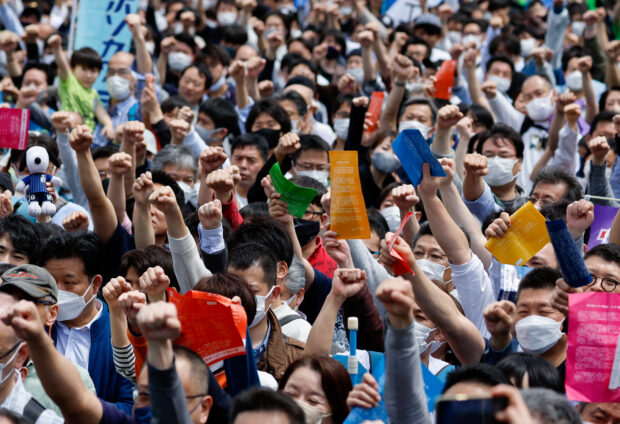
Members of the Japanese Trade Union Confederation, commonly known as Rengo, raise their fists as they shout Gambaro and cheer during their annual May Day rally to demand higher pay and better working conditions, in Tokyo, Japan April 29, 2023. REUTERS/Issei Kato/File photo
TOKYO – Japan’s regular pay grew at the fastest pace in over 28 years in May, government data showed on Friday, as wage hikes induced by labor talks this spring started to take effect.
Base salary soared 1.8 percent in May year-on-year, the biggest rise since February 1995.
Wage growth is one of the key trends on the Bank of Japan’s(BOJ) radar as the central bank considers if and when it should unwind its ultra-loose monetary stimulus.
Japan firms offer biggest pay hikes in 30 years, wage growth broadens
BOJ Governor Kazuo Ueda has repeatedly stressed the need to keep policy accommodative until wages increase enough to keep price growth sustainably around its 2 percent target.
The country’s largest trade union group Rengo said on Wednesday its member unions saw the biggest pay increase in three decades, with an average hike of 3.58 percent, at this year’s salary negotiations.
The results from the labor talks will be reflected toward the summer, labor ministry officials said.
Total cash earnings, or nominal wages, increased 2.5 percent year-on-year in May, after rising a revised 0.8 percent in April.
The consumer price index the ministry uses to calculate real wages, which includes fresh food prices but excludes owners’ equivalent rent, grew but at a slower pace of 3.8 percent gain in May from a 4.1- percent jump in April.
Inflation in Tokyo slows in May, but key gauge hits four-decade high
Inflation-adjusted real wages, a barometer of households’ purchasing power, dropped 1.2 percent in May from a year earlier, falling for 14 months straight.
Special payments jumped 22.2 percent in May, after a revised 0.7 percent gain in April. The indicator tends to be volatile in months outside the twice-a-year bonus seasons of November to January and June to August.
Overtime pay, a gauge of business activity, edged up 0.4 percent in May from a year earlier, compared with a revised 0.7 percent drop in April.

